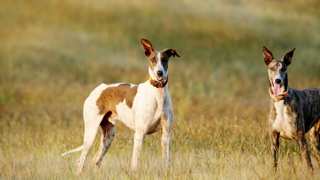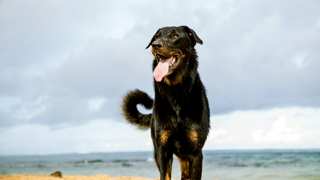The Doberman is muscular, athletic, and energetic, so Doberman exercise requirements are extensive. These dogs will need a wide variety of physical activities that condition their breathing and circulation (walking, fetch), work out those considerable Doberman muscles (weight pulling), and stimulate them mentally (games, canine sports). They make excellent jogging and bicycling companions as well. Overall, a big part of the Doberman exercise routine should include running in a large, fenced yard.
Specifically how much exercise does a Doberman need? The typical adult Dobie, depending on its age and overall activity level, will need about 90 minutes of proper exercise per day--which you can accomplish with a couple of long walks, jogs, or bike rides and a dedicated period of play. You can start exercising your Dobie puppy when it's three months old by taking it on short (5- to 7-minute) walks, then you can increase the walks' length and frequency as the puppy grows. And these early walks are a good opportunity to start teaching your young Dobie obedience, through leash training: have the puppy walk beside or behind you on the leash instead of being allowed to lead or "tug" on it. This, in the puppy's mind, establishes you as the leader, and should make training easier as the dog matures.
A few precautions to consider with Doberman Pinscher exercise: first, puppies younger than nine months old shouldn't participate in activities that include a lot of jumping, running on hard surfaces, or navigating of stairs, as doing so can injure their still-developing joints and bones. Regardless of age, putting your Dobie on a leash when in public is an absolute must. While not instinctively aggressive, these dogs are bold, confident, and protective, and won't hesitate to defend their humans from unknown people or animals--especially if they perceive a potential threat. A leash will help you control your Dobie in these situations. Even when exercising in your own yard (which is hopefully large!), the area will need to be securely fenced to keep the dog from running away or from confronting unknown passersby. Also, deep-chested breeds like the Doberman are prone to suffering gastric torsion (bloat), an often-fatal digestive issue that occurs when a dog "wolfs" its food and its stomach fills with air; the condition often appears when a dog exercises just before or after eating. It's best, therefore, not to exercise your Dobie for an hour before or two hours after eating. And finally: Dobermans are definitely "family dogs," so they'll respond much better to exercises they do along with their people rather than exercising alone.
Safeguard aside, it's important to exercise your Dobie every single day. These dogs are lively and enthusiastic, and without consistent activity they'll become frustrated, destructive, and at the worst, aggressive. Regular exercise will be great for both the dog's and your own peace of mind! A few exercise ideas:
- Walking/Jogging/Bicycling: Two 30-minute walks (or 20-minute jogs or bike rides) per day is a good target
- Fetch/Frisbee: These dogs will chase a ball, stick, or Frisbee for hours
- Weight Pulling: Attach a rope to a heavy object like a spare tire, and the other end to a harness for the dog
- Tug-of-War: Good indoor, rainy-day activity; use a rope or old towel
- Dog Park: If properly socialized, Dobermans enjoy the company of other dogs; be sure to use a leash
- Canine Sports: Dobies are fantastic competitors in obedience and agility trials, flyball, and other events
- Hiking: Excellent bonding activity; bonus if you can find a remote area where the dog can be off-leash
When indoors, it's a good idea to give your Doberman access to one or more balls or toys that will allow the dog to burn excess energy. It's also recommended that you establish a regular Doberman exercise routine, such as walks, jogs, or bike rides in the morning and evening and a play period in the afternoon.





